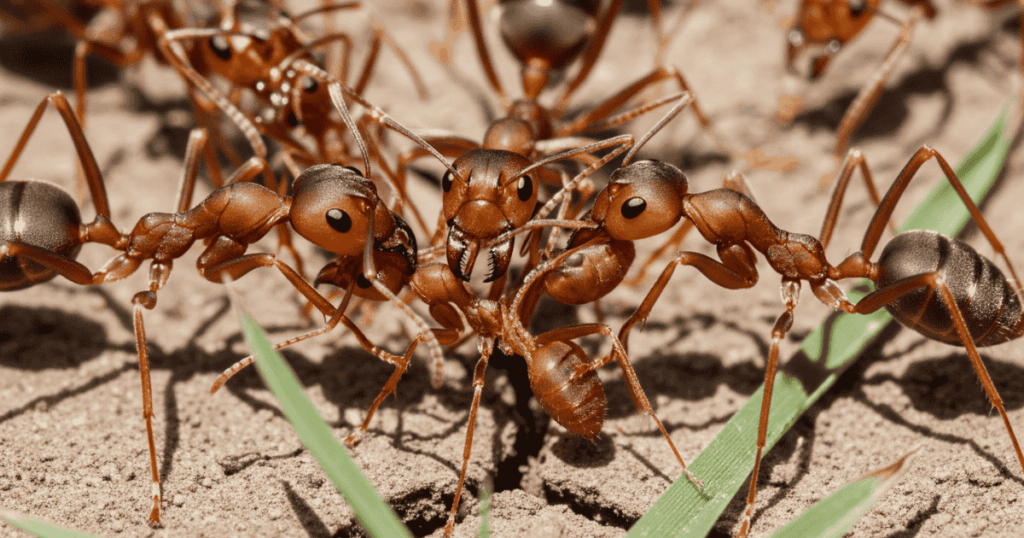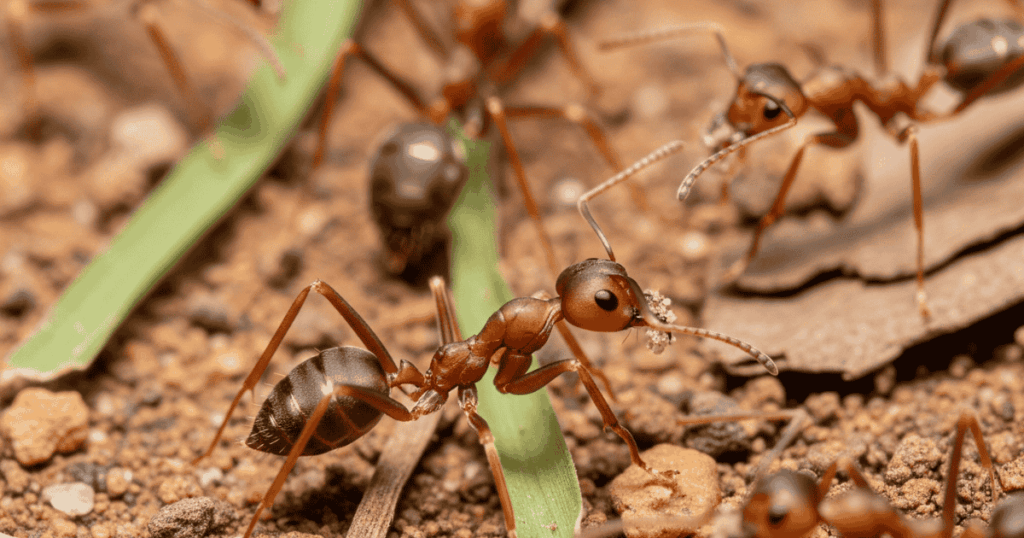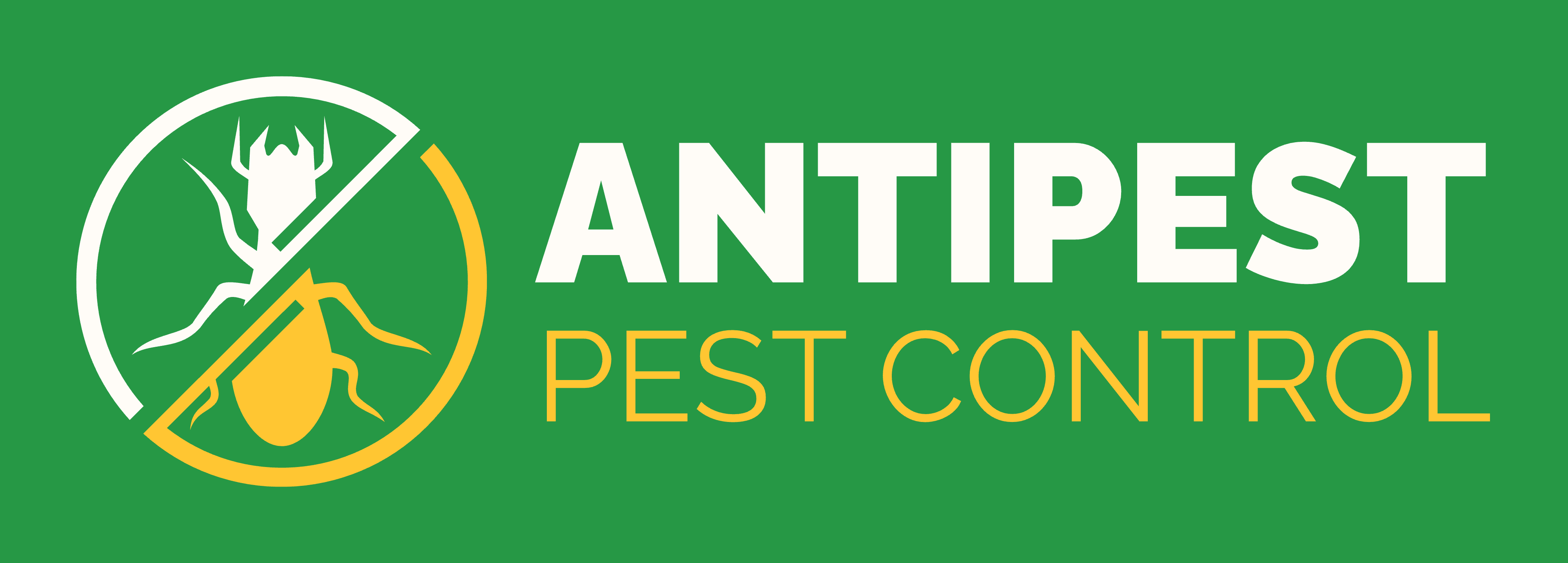Fire ants vs red ants is a common comparison homeowners make when spotting reddish ants in yards, gardens, or kitchens, yet the terms do not always mean the same thing and can affect response and treatment choices significantly. Fire ants vs red ants matters because true fire ants (Solenopsis) sting, build distinctive mounds, and can trigger medical emergencies, while many “red ants” are other species that mostly bite and are less aggressive.
Understanding fire ants vs red ants helps identify mounds, size, behavior, and sting risks to choose safe, effective control methods. If a yard has multiple reddish species, clear identification of fire ants vs red ants reduces wasted treatments and unnecessary exposure to insecticides.
Table of Contents
What are Fire Ants?
Fire ants are aggressive ants that belong primarily to the Solenopsis invicta species. They are notorious for their painful stings and their ability to swarm quickly when disturbed. Unlike many other species, fire ants create large mound nests that can damage lawns, electrical equipment, and crop fields.
Their bites are especially dangerous because of the venom they inject, which produces a burning sensation, hence the name “fire” ants. In severe cases, allergic reactions may even require medical treatment.
What Are Red Ants?
The term “red ant” is often used as a broad category for ants with reddish coloring, such as Formica or Myrmica species. These ants are not as aggressive as fire ants, and their bites are irritating but not medically serious. Most red ants are garden-inhabiting or soil-nesting ants that play beneficial roles in ecosystems, helping with soil aeration and controlling pests.
Unlike fire ants, red ants rarely attack in large groups unless their nest is directly threatened.
Key Differences: Appearance – Fire Ants vs Red Ants

Appearance is one of the most effective ways to differentiate fire ants from red ants. Although both share a reddish hue, their size, body shape, and distinct features vary.
Fire Ant Appearance
Fire ants are reddish-brown with darker abdomens. They range in size from 1/16 inch to 1/4 inch within the same colony due to worker polymorphism. Their mandibles are strong, and they have a stinger at the back end.
Red Ant Appearance
Red ants are often larger on average (1/4 to 1/2 inch), lacking the noticeable variation in size seen with fire ants. Their bodies are less shiny and may appear with more uniform red or reddish-brown tones.
Comparison Table – Physical Differences
| Feature | Fire Ants | Red Ants |
| Color | Reddish-brown with darker ends | Uniform red or rusty-brown |
| Size Range | 1/16 – 1/4 inch, varied size | 1/4 – 1/2 inch, consistent size |
| Aggressiveness | Highly aggressive | Mildly aggressive |
| Defining Feature | Painful sting, glossy body | Less shiny body, weaker sting |
Types of Fire Ants and Red Ants

Understanding the varieties within fire ants vs red ant helps identify which species you’re facing. Among fire ants, the Red Imported Fire Ant (Solenopsis invicta) is the most common and aggressive, notorious for painful stings and large mounds. Another species is the Black Imported Fire Ant (Solenopsis richteri), which shares many characteristics but has a slightly different coloration.
For red ants, the group is broader and includes species like Carpenter ants, Velvet ants (actually wasps), and Acrobat ants, which are sometimes mistaken for fire ants due to their similar color. These red ants are generally less aggressive. Knowing the specific ant types within the fire ant vs red ants category can guide targeted control measures.
Major Types of Fire Ants vs Red Ants
| Species/Type | Classification | Color/Size | Aggressiveness | Notable Features |
| Red Imported Fire Ant | Fire Ant (Solenopsis invicta) | Red-brown with dark abdomen, 1.5-7 mm | Highly aggressive | Painful sting, mound builder |
| Black Imported Fire Ant | Fire Ant (Solenopsis richteri) | Darker color, size similar to red ants | Aggressive | Venomous sting, hybridizes with red imported ants |
| Tropical Fire Ant | Fire Ant | Copper brown, smaller | Aggressive | Localized to warmer areas |
| Carpenter Ant | Red Ant | Large (up to 12 mm), red or black | Mild to moderate | Wood nesters, bite but don’t sting |
| Velvet Ant | Red Ant (Wasp) | Fuzzy bright red/orange, small | Painful sting (wasp) | Actually wasps, not ants |
| Acrobat Ant | Red Ant | Small, reddish, 2-3 mm | Mild | Raises abdomen when disturbed |
How to Get Rid of Fire Ants vs Red Ants?

The best approach to controlling fire ant vs red ants depends on colony size and location. Here’s a step-by-step guide:
- Identify the colony type – Look for mound shape (fire ants) or hidden nests (red ants).
- Apply natural solutions first – Test with boiling water, vinegar, or diatomaceous earth for mild infestations.
- Use ant bait granules – Fire ants vs red ant forage for food, so they carry bait back to the colony.
- Monitor your lawn and garden – Eliminating only surface workers won’t solve the problem. Watch for colony regrowth.
- Know when to escalate – If fire ants and red ants persist after natural attempts, chemical or professional solutions may be required.
Behavior and Aggression: Fire Ants vs Red Ants
Ant behavior is a significant factor in telling fire ants vs red ants apart.
Fire Ant Behavior
Fire ants are notorious for their swarming attacks. If their mound is disturbed, dozens or even hundreds of ants rush out and sting repeatedly in unison. They are highly territorial and will actively defend their colony.
Red Ant Behavior
Red ants do not swarm aggressively but may bite if handled or stepped on. They are more inclined to forage for food and protect their nest without mass stinging.
Habitat and Nesting: Fire Ants vs Red Ants

Both types of ants build colonies, but their nesting preferences are different.
Fire Ant Habitat
Fire ants prefer sunny, open areas like lawns, pastures, and agricultural fields. Their nests appear as large dome-shaped mounds, sometimes reaching 18 inches tall.
Red Ant Habitat
Red ants build nests in soil, under rocks, logs, or within garden beds. Unlike fire ants, their nests do not form large, visible soil mounds, making them less intrusive in lawns.
Table – Nest and Habitat Comparison
| Feature | Fire Ants Nest | Red Ants Nest |
| Nest Shape | Dome mound, visible on soil | Underground, hidden, under rocks |
| Preferred Area | Open sunny lawns, pastures | Gardens, wooded soil, shaded areas |
| Nesting Impact | Damages lawns and crops | Usually harmless to yards |
“Discover the surprising differences between red ants vs black ants – and learn which one you should really watch out for!”
Stings and Medical Risks: Fire Ants vs Red Ants
Probably the most important distinction in fire ant vs red ants is the effect of their bites and stings.
Fire Ant Stings
Fire ants sting and inject venom, leaving behind painful welts that turn into white pustules within 24 hours. Multiple stings may cause intense itching, burning, and in rare cases, life-threatening allergic reactions.
Red Ant Bites
Red ants may bite but they do not sting. The irritation is mild, resulting in a small red bump or itch. These are not typically dangerous to humans or pets.
Symptoms Table
| Symptom | Fire Ant Stings | Red Ant Bites |
| Pain Level | High – sharp burning pain | Low – mild irritation |
| Swelling | Prominent, with pus-filled bumps | Small localized bump |
| Allergic Reactions | Possible severe allergic responses | Rarely any |
| Medical Treatment | Sometimes needed (antihistamines, EpiPen) | Usually not required |
Signs of Fire Ants vs Red Ants Infestation
Early detection is important to prevent widespread ant problems. Signs of fire ants and red ants infestation include:
- Presence of mounds: Fire ants build distinctive dome-shaped mounds with no entrance hole, usually in sunny areas. Red ants tend to nest underground or under debris with less visible mounding.
- Aggressive swarming: Disturbing a fire ant mound will provoke a rapid swarm attack, while red ants seldom show aggressive group behavior.
- Indoor sightings: Fire ants may invade warm places indoors near electrical outlets or kitchens during harsh weather, whereas red ants are typically found indoors searching for food but without stinging.
- Damage signs: Fire ants can damage electrical wiring and crops, while red ants might cause structural damage if they include carpenter ants.
- Bite/sting marks: Fire ants leave painful stings with pustules, while red ants generally cause mild bites or irritation.
Knowing these signs helps differentiate fire ants and red ants infestations early on.
Roles in the Ecosystem
Not every ant is harmful, and understanding fire ants and red ants in an ecological context helps clarify why control matters.
- Fire Ants: While they prey on pests like ticks and caterpillars, their destructive nature in agriculture outweighs benefits. They can damage plants, injure livestock, and kill native insects.
- Red Ants: These ants can improve soil fertility, recycle organic matter, and serve as natural pest controllers in gardens. They are generally considered beneficial to ecosystems.
Fire Ants vs Red Ants Control
If you’re dealing with ant infestations, knowing whether you have fire ants or red ants determines the control method.
Fire Ant Control
- Apply bait treatments that ants carry back to the colony.
- Use mound drenches with insecticides for larger infestations.
- Repeated monitoring is essential since new queens can quickly establish colonies.
Red Ant Control
- Red ants usually don’t require aggressive control unless nests are near homes.
- Natural deterrents like boiling water or diatomaceous earth can reduce colonies.
- Encouraging natural predators (birds, other insects) can help balance populations.
Fire Ants vs Red Ants – Quick Overview
To make it easier, here’s a combined summary:
| Aspect | Fire Ants | Red Ants |
| Aggressiveness | Highly aggressive, swarm stings | Less aggressive, single bite |
| Nest | Large visible mound | Small, hidden nests |
| Bite/Sting | Painful sting with venom | Mild bite, no venom |
| Medical Risk | Serious, allergic reactions possible | Minimal, harmless |
| Ecosystem Impact | Harmful to environment & crops | Often beneficial in gardens |
“Struggling with fire ant mounds? Find out exactly How to Get Rid of Fire Ants fast.”
Natural Home Remedies for Fire Ants vs Red Ants
When dealing with fire ants and red ants in your yard or garden, many homeowners prefer starting with natural remedies before using chemicals. These household solutions are safer for pets, children, and the environment while still reducing ant colonies over time.
Natural Remedies You Can Try:
- Boiling Water: Pouring boiling water directly over nests can kill a significant number of fire ants and red ants, though it may require repeated attempts.
- Citrus Oil or Lemon Juice: Citrus compounds disrupt ant pheromone trails. Spraying diluted citrus oil near the nest helps deter fire ants and red ants from returning.
- Vinegar Solution: A simple mix of vinegar and water can be used to wipe trails, making it harder for fire ants vs red ants to navigate.
- Diatomaceous Earth: This food-grade powder cuts into the exoskeleton and dehydrates fire ants and red ants when sprinkled near nests.
- Cornmeal Trick: Ants eat cornmeal but cannot digest it well, eventually weakening colonies of fire ants and red ants.
Natural remedies are best suited for small infestations, but fire ants are resilient, and results may take time.
Chemical Methods for Fire Ants vs Red Ants
When natural options fail, chemical solutions are the next step in controlling fire ants vs red ants. Chemical treatments can be highly effective if used correctly and safely.
Common Chemical Methods:
- Ant Baits: Specially formulated granules attract worker fire ants and red ants, who carry poison back to the queen.
- Mound Treatments: Direct applications of liquid insecticide over fire ants and red ants nests kill colonies quickly.
- Broadcast Insecticides: Granular treatments spread across lawns to prevent future fire ants and red ants invasions.
- Dust Insecticides: Useful for applying around crevices where fire ants vs red ants may nest.
It’s important to follow safety guidelines since these products can harm pets, children, and beneficial insects if misused. Many experts recommend combining bait + mound treatment to completely wipe out fire ants vs red ants.
Preventing Re-Infestation of Fire Ants vs Red Ants
Preventing a future infestation requires eliminating favorable conditions for both fire ants vs red ants:
- Maintain clean and dry spaces: Remove food scraps, spills, and standing water to limit attractants for all ants.
- Seal entry points: Block cracks around doors, windows, and foundations to stop indoor invasion by fire ants vs red ants.
- Regular yard maintenance: Keep lawns trimmed and free of debris, especially near sidewalks and patios where ant mounds commonly appear.
- Rethink garden mulch and wood piles: Avoid excessive moisture and stacked wood that can attract various red ants and fire ants.
- Use appropriate barriers and repellents: Natural deterrents or chemical barriers around house foundations can reduce the chance of fire ants vs red ants returning.
When to Call a Professional for Fire Ants vs Red Ants?
Controlling fire ants vs red ants can become overwhelming if infestations are large or recurring. Calling a pest control professional is often the best option when:
- Fire ant mounds spread rapidly across lawns or pastures.
- Bites or stings have caused allergic reactions in family members.
- DIY methods have failed to control fire ants vs red ants after repeated efforts.
- Colonies are located near electrical systems, playgrounds, or heavily used areas.
- Fire ants vs red ants threaten pets, livestock, or crops.
Professional pest control brings expertise, stronger treatments, and long-term monitoring that DIY options cannot match.
For comprehensive and hassle-free Fire Ants vs Red Ants removal and long-term pest prevention, trust the professionals at Antipest Office. Visit us at the Antipest Office, Our trained technicians use safe and effective methods to protect your home and business. For service bookings and consultations, call us at +91 9819018398 .
Professional vs DIY Methods for Fire Ants vs Red Ants
Let’s break down the advantages and disadvantages of each approach when tackling fire ants vs red ants:
| Approach | Advantages | Disadvantages |
| DIY (Natural/Store) | Low cost, safe, easily available. Great for small nests of fire ants vs red ants. | Limited effectiveness on large colonies. |
| Professional | Long-lasting results, stronger products, expert advice for fire ants vs red ants. | Higher cost, requires scheduling. |
For small garden nests of fire ants vs red ants, DIY may suffice. For aggressive or widespread colonies, professional treatment is worth the investment.
Long-Term Action Plan for Fire Ants vs Red Ants Management
An effective long-term plan to control and prevent fire ants vs red ants should include:
- Routine monitoring: Inspect yards weekly during warmer months for new mounds or ant trails.
- Combination control methods: Use natural remedies initially, followed by targeted baiting and chemical treatments when needed.
- Professional inspections: Schedule expert pest control every 1-2 years for preventive treatments, especially in high-risk areas.
- Educate household members: Teach family how to identify fire ants vs red ants and respond properly to bites or sightings.
- Record keeping: Keep notes on treatments used, locations of nests, and ant activity patterns to optimize future control efforts.
Sticking to a detailed long-term approach reduces fire ants vs red ants populations and protects your home and yard sustainably.
Conclusion
Fire ants vs red ants is more than a naming quirk, it determines health risk, mound behavior, and the kind of control that actually works, especially in sunny, disturbed lawns and gardens. Fire ants sting, swarm, and form pustules, calling for bait‑based, colony‑level strategies and careful first aid; most other “red ants” mostly bite and respond better to habitat and species‑specific tactics. Keeping fire ants vs red ants straight prevents wasted treatments and helps protect families, pets, and neighbors from painful encounters while restoring outdoor spaces to safe, usable condition.
Fire Ants vs Red Ants – FAQs
What is the difference between fire ants vs red ants?
Fire ants sting with venom causing painful reactions, while red ants usually bite, resulting in mild irritation without serious medical risk.
How can you identify fire ants vs red ants in appearance?
Fire ants are smaller, reddish-brown, and vary in size within colonies, while red ants are larger, uniformly red, and lack stingers.
Where do you commonly find fire ants vs red ants?
Fire ants prefer sunny lawns, pastures, and fields with visible mounds, while red ants usually nest under rocks, garden beds, or shaded soils.
Are the stings of fire ants vs red ants equally harmful?
No, fire ant stings cause burning pain and potential allergic reactions, while red ant bites are mild and generally harmless.
How do the nests of fire ants vs red ants differ?
Fire ants build dome-shaped mounds above ground, whereas red ants create smaller underground nests hidden in soil, wood, or shaded areas.
What role do fire ants vs red ants play in ecosystems?
Fire ants disrupt ecosystems, damage crops, and harm wildlife, while red ants contribute positively by aerating soil and controlling pests.
What is the best way to control fire ants vs red ants infestations?
Fire ants require bait treatments or insecticides due to aggression, while red ants are manageable with natural remedies and often don’t need elimination.
What’s the simplest way to tell fire ants vs red ants apart?
Look for two waist nodes, no central mound opening, rapid swarming on disturbance, and stings that form sterile pustules within 24 hours, classic fire ant signs.
Can pets be harmed by fire ants vs red ants?
Pets can suffer multiple fire ant stings; move them away, brush ants off, give a cool bath, and see a vet if allergic signs appear or pain persists.
Why does “fire ants vs red ants” matter for safety?
Fire ants can cause pustules and severe allergic reactions, so correct ID changes first aid urgency and the control plan selected for the site.

